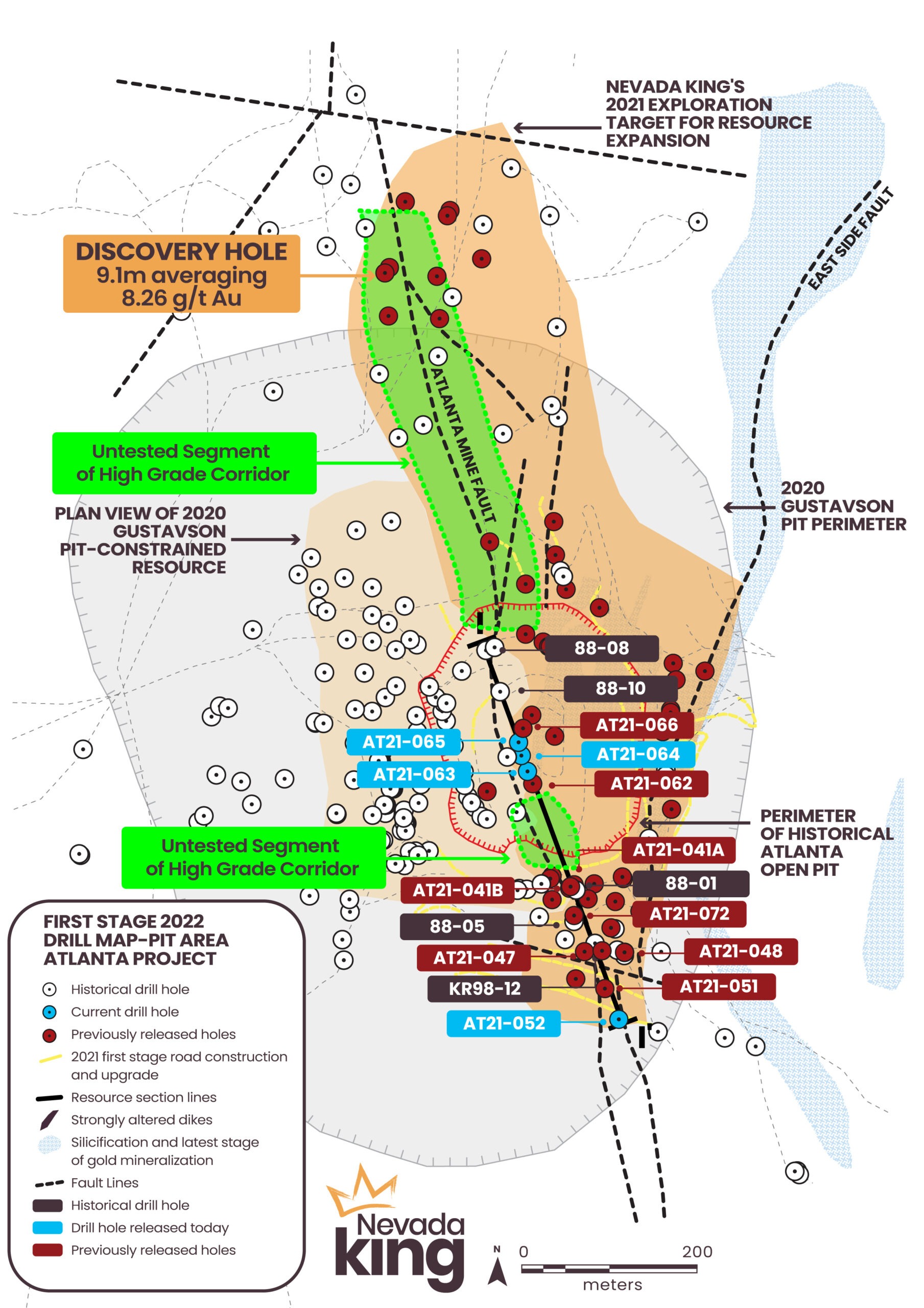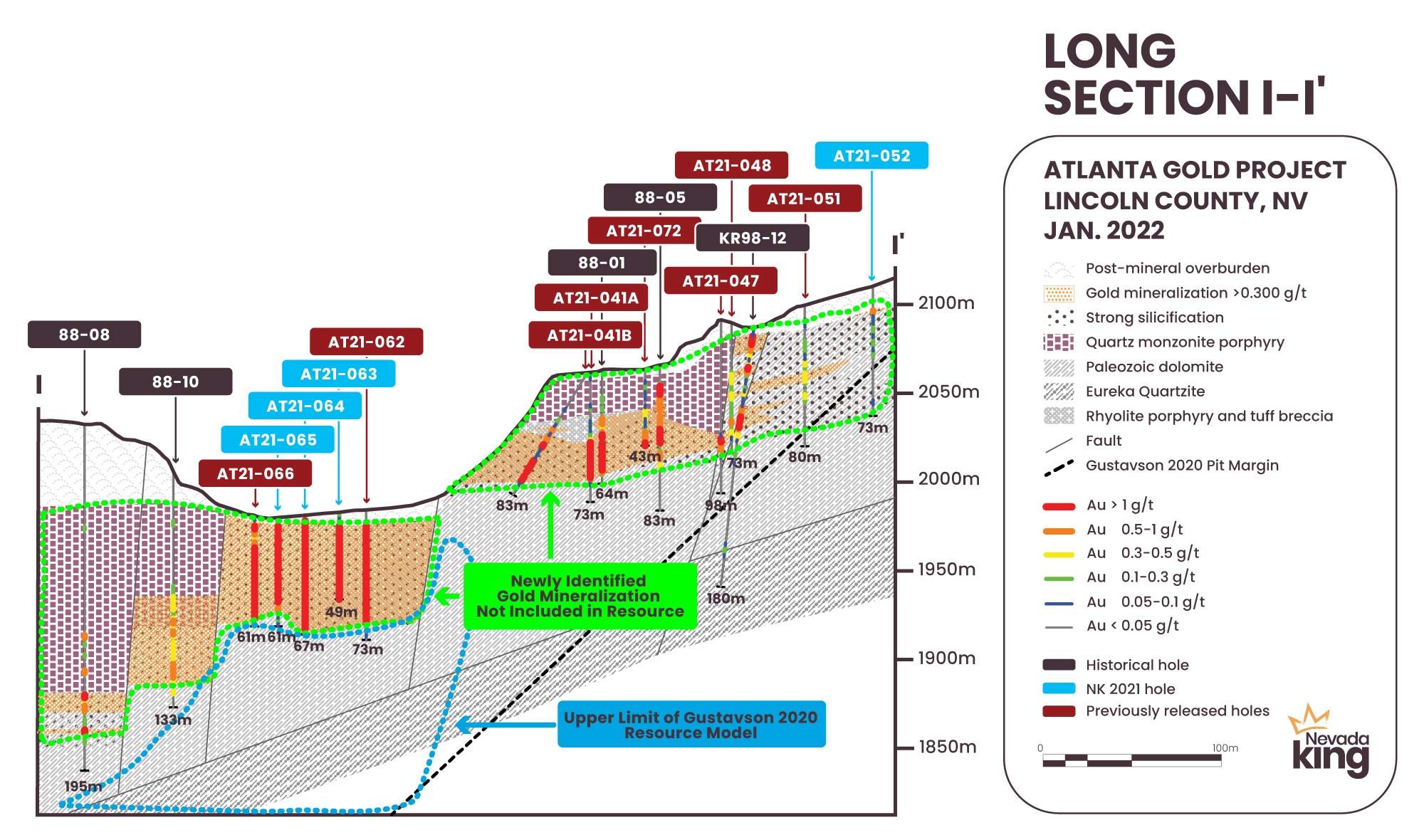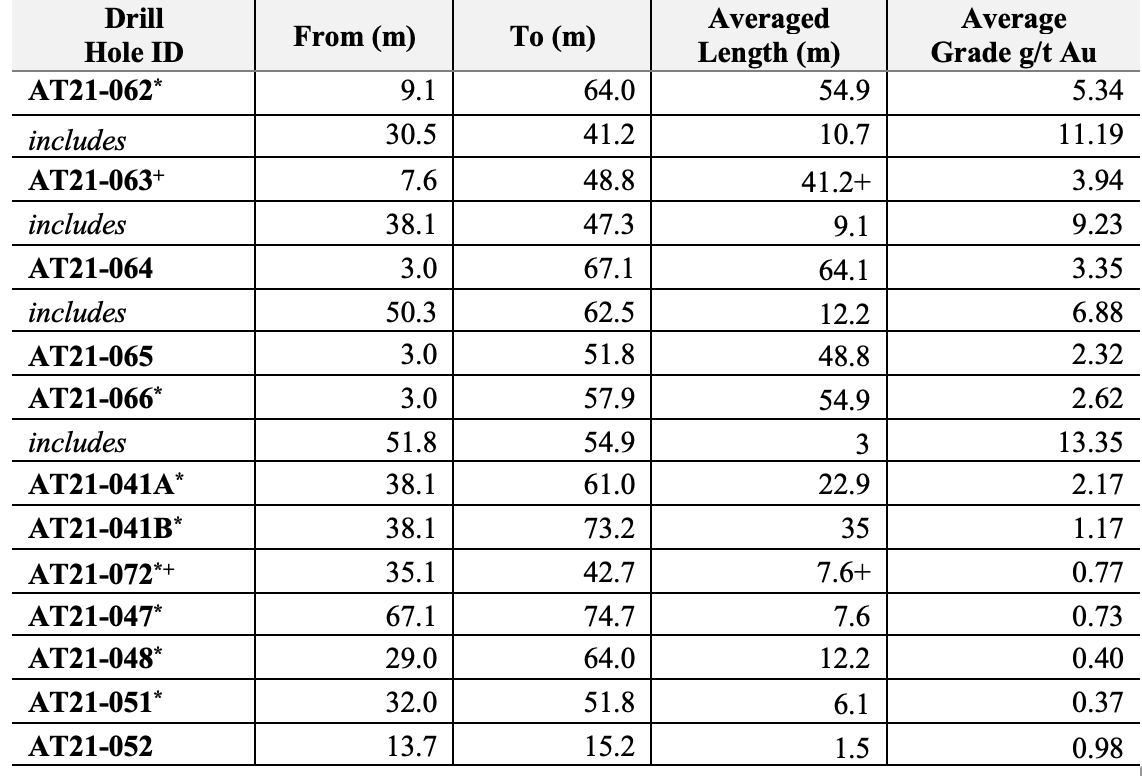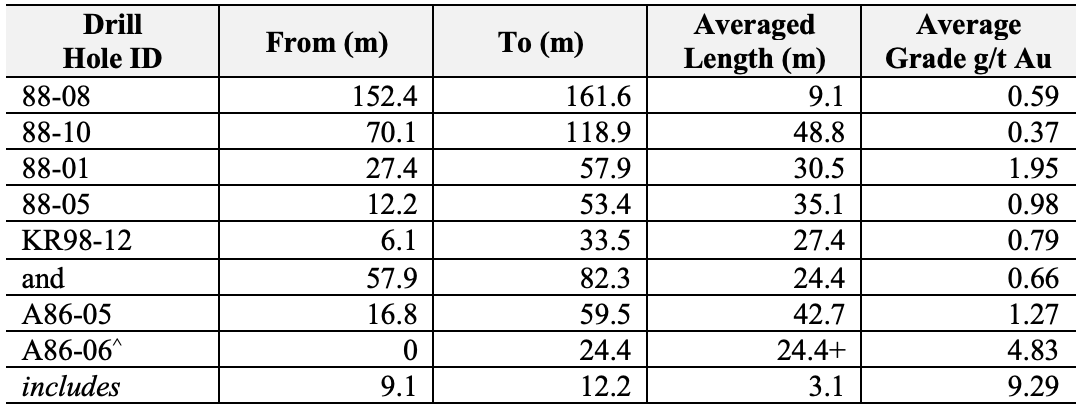VANCOUVER, BC, January 20, 2022 – Nevada King Gold Corp. (TSX-V: NKG; OTCQX: NKGFF) (“Nevada King” or the “Company”) is pleased to announce results from three new vertical RC holes drilled within the historical Atlanta pit (Figure 1) collared between holes AT21-066 (released December 1, 2021) and AT21-062 (released January 12, 2022). The Atlanta Mine Project is 100% owned by Nevada King and is located 264km northeast of Las Vegas, Nevada, in the prolific Battle Mountain Trend.
Highlights
- Highlight intervals are summarized below with additional results provided in Table 2.

The true thickness of the reported intervals are estimated to be in the range of 70% to 85% of reported intervals.
+Denotes hole terminated in mineralization due to lost circulation.
- Vertical RC drill hole AT21-063, drilled from within the Atlanta pit, encountered 41.2m averaging 3.94 g/t Au starting at 7.6m depth. The mineralized rock is oxidized and includes a high-grade intercept of 9.1m averaging 9.23 g/t Au starting at 38.1m.
- The adjacent vertical RC hole AT21-064 (17 metres to the N of AT21-063) encountered 64m averaging 3.35 g/t Austarting at 3m depth. The mineralized rock is also oxidized and includes a high-grade intercept of 12.2m averaging 6.88 g/t Au starting at 50.3m.
- A third adjacent vertical RC hole AT21-065 (17 metres to the N of AT21-064) encountered 48.8m averaging 2.23 g/t Au starting at 3m depth, and is also oxidized.
- These three holes are part of a fence of five holes (Figure 2) drilled along a 70 metre long north-south line that despite its location at the bottom of the pit had never been drill tested. Holes AT21-066 and ATR-21-062 also drilled on this fence line graded 54.9m averaging 2.62 g/t Au and 54.9m averaging 5.34 g/t Au, respectively (see December 1, 2021, and January 12, 2022, news releases).
- The envelope targeted by this five hole fence line was previously categorized as waste in the Company’s current National Instrument 43-101 (“NI 43-101”) Atlanta property resource estimate, prepared by Gustavson in 2020.
- This newly identified at surface high-grade gold mineralization ties together with known high-grade historical gold intercepts at depth, better confirming the accuracy of high-grade historical intercepts. The Atlanta Mine Fault Zone is now drill defined over a strike length of approximately 1km, extending 550m to the north-northwest of the historical pit where Nevada King drilled AT21-003 (released November 22, 2021) assaying 9.1m averaging 8.26 g/t Au (Figure 1).
- This high-grade mineralization is currently open to the north and south where sizeable additional gaps exist in the historical drilling pattern (Figure 1). The 150m gap between AT21-062 and AT21-041B spatially coincides with the zone of shallow subsidence seen at the SW end of the historical pit and is a high priority target for the next phase of drilling.
- Similar potential for discovering additional gold resources and with a likely collateral reduction in the strip ratio is seen south of the historical pit (Figure 2), where the combination of Nevada King and historical holes now identifies mineralization that is well outside of the Gustavson resource model, but within the conceptual pit. Furthermore, this mineralization tracks south of the Gustavson conceptual pit, where mineralization remains open.
Cal Herron, Exploration Manager of Nevada King, stated: “In summary, the Phase I drill program at Atlanta was a smashing success, exceeding our goals and expectations. Given the strong gold mineralization in AT21-062 through AT21-066, the glaring gap south of these holes, as well as the high-grade hit in AT21-003 located 550m to the north-northwest, Nevada King is well on its way towards building a shallow, robust, oxidized resource along the 1km trace of the Atlanta Mine Fault Zone. It is important to remember that while today’s high-grade shallow mineralization occurs within the confines of the Gustavson 2020 conceptual pit, it was not included in the Gustavson 2020 NI 43-101 resource model. Our team is working towards finalizing an upcoming 2022 drill program at Atlanta, which will involve a high density drilling component following up on this high-grade corridor.”


Drillhole Details

The true thickness of the reported intervals are estimated to be in the range of 70% to 85% of reported intervals. +Denotes hole terminated in mineralization due to lost circulation. *Denotes Nevada King hole previously released.

^Denotes hole that bottomed in mineralization.
Overview
Vertical RC holes AT21-062 through AT21-066 were drilled along a south to north line 70m long with holes spaced about 17m apart (Figure 1). As seen in Table 2, the gold grades gradually decrease from AT21-062 to AT21-065, then start to increase at AT21-066. The overall mineralized intercept lengths are similar, ranging from 41m to 64m. All except AT21-063 fully penetrated the silicified zone and bottomed in unmineralized dolomite. All except AT21-065 possessed higher grade sample intervals greater than 5 g/t Au. With these five closely spaced holes, Nevada King established a gold gradient along a 70m stretch of the Atlanta Mine Fault Zone, with the grade vector clearly pointing southward from AT21-062 toward the southwestern corner of the Atlanta pit. In order to chase the mineralization southward, the Company will be constructing new roads within the next two months to accommodate additional core and RC drilling when the weather moderates in March.
The 2021 drilling program conclusively demonstrated the existence of low and moderate grade gold mineralization north, south, and east of the Gustavson 2020 resource model such that good potential exists for significantly reducing the strip ratio upon mining. Additional drilling in 2022 will be needed in order to realize this potential, but exploration moving forward will focus more on expanding the shallow, higher grade potential seen along the Atlanta Mine Fault Zone. As of this release, all RC holes drilled in 2021 by Nevada King at Atlanta within and along strike of the Gustavson 2020 resource model have been disclosed. Results for three core holes drilled in November 2021 are still pending.
Drill Results Along Section I-I’ and in the Vicinity
Assay results from Nevada King’s RC drilling along Section I-I’ and within the vicinity are reported above in Table 2, while historical hole intercepts are contained in Table 3. Averaged intercepts utilize a 0.30 g/t external cut-off grade. The reported intercepts are down-hole lengths and may not represent true thickness of mineralization. However, the silicified replacement zone hosting most of the gold mineralization at Atlanta generally dips from 10o to 30o west, so vertical holes and steeply eastward inclined angle holes come close to true thickness. High-grade hits (>5 g/t Au) such as those reported along Section I-I’ may be controlled by high angle faults or veins like ones sampled along the Atlanta pit benches, so additional close-spaced drilling is needed in order to determine strike and dip of these high grade intervals.
The drill section in Figure 2 shows a series of fault blocks progressively downdropped to the north, but in reality the faults cut across the section at a low angle and possess northerly strikes, so the series of fault blocks are actually downdropped to the west as shown in previous releases utilizing E-W oriented section lines. Gold mineralization is hosted in strongly silicified collapse breccia within the Laketown Dolomite underneath the base of a quartz monzonite porphyry sill and associated tuffaceous facies. A late stage WNW-striking, moderately north dipping fault downdropped the dolomite section next to the Eureka Quartzite unit.
The high-grade mineralization hit in AT21-062 projects southward along the Atlanta Mine Fault zone into an area of low historical drill density measuring about 100m long by 50m wide that possesses only one qualified historical hole. Located 43m south of AT21-062, historical angle core hole DHRI-11-01C drilled by Meadow Bay in 2011 hit 21.3m grading 2.01g/t Au starting at 74.7m depth, which indicates mineralization along the Atlanta Mine Fault Zone continues southward toward Nevada King’s vertical RC hole AT21-041A (Figure 2). Bobcat drilled two, well mineralized vertical RC holes A86-05 and A86-06 somewhere in the vicinity of AT21-064 and AT21-062 (Figure 2) in 1986, but inaccurate collar locations kept both holes out of Gustavson’s 2020 resource model and off of Section I-I’. A86-06 reported 24.4m+ grading 4.83g/t (Table 2) starting at surface, so it probably collared south of AT21-062 at the bottom of the pit as opposed to 60m further westward where historical maps plot the hole.
The gap in historical drill hole coverage south of AT21-062 is largely attributed to lack of access caused by pit wall collapse soon after cessation of mining in 1985. Furthermore, shallow subsidence most likely due to collapse of historically-mined underground stopes along the Atlanta Mine Fault zone further exacerbated pit wall instability. Lack of access coupled with the prospect of encountering shallow stopes limited historical exploration drill tests to deep intersections beneath this 150m long portion of the vein zone, so no reliable shallow historical drill data exists within this part of the property. Moving forward into 2022, Nevada King will be stabilizing portions of the collapsed pit wall in order to track the shallow high grade mineralization hit in AT21-062 further southward.
Historical holes drilled along the southern portion of Section I-I’ reported significant gold intercepts but were not included in the Gustavson resource model due to low hole density, inaccurate collar locations, and suspect assays. Nevada King’s vertical RC hole AT21-041A was positioned near a historical open drill hole thought to be Bobcat’s vertical RC hole 88-01. The 22.9m grading 2.17g/t in AT21-041A is fairly close to the 30.5m grading 1.95g/t reported in 88-01, so the 88-series Bobcat holes appear to be reasonably accurate with respect to both location and assaying. We can therefore use the 88-01 series holes as guides for following mineralization north and south of the historical pit, particularly to the north where vertical hole 88-10 encountered 48.8m averaging 0.37g/t. The reported intercept is low grade, but examination of the chip trays revealed both 88-10 and adjacent hole 88-08 were drilled with a tricone bit, meaning there was severe loss of the fine fraction within the silicified zone. We can use the 88-series holes for establishing location of gold mineralization, but they must be twinned with a center-return hammer or core in order to establish reliable grade. Nevada King’s examination of its own RC samples revealed up to a 50% drop in Au grade with loss of loose-bound oxides, clay, and strongly decalcified dolomite comprising the fine fractions.
Looking at the overall distribution of gold along Section I-I’, a tapering-off in gold grade appears at the northern and southern ends of the section. This is in part due to the Atlanta Mine Fault Zone jogging eastward out-of-section at the northern end and westward out-of-section at the southern end. At a more macroscopic level, we are probably seeing pinching and swelling of the hydrothermal system itself along strike of the Atlanta Mine Fault Zone, which is common in fault-dominated epithermal systems. In 2022, Nevada King will be following the main structural trend looking for additional swell segments along the Atlanta Mine Fault Zone. The Company already has idenitified what appears to be a second swell zone north of the historical pit along Section B-B’ (released November 22, 2021) that requires detailed drilling, while the potential south of Section I-I’ remains entirely untested and unknown.
The Company is currently waiting on assay results from three core holes, while the 2021 RC drilling results are now fully diclosed. Overall, Nevada King found more gold and higher grades than were expected given the historical data. Nevada King’s denser drill hole patterns within shallow portions of the Atlanta epithermal system reveal a near-horizontal silicified replacement horizon hosting the bulk of gold mineralization that was progressively down-dropped westward along a series of high-angle, northerly trending faults collectively referred to as the Atlanta Mine Fault Zone. These high-angle faults served as the “feeder” structures for channeling gold-bearing fluids into the low-angle, silicified collapse breccia zone that occurs along the basal contact of a gently west-dipping quartz monzonite sill. This model for mineralization at Atlanta differs substantially from the historical structural model that posited gold mineralization along a 45o west-dipping listric fault (the Atlanta Vein) that flattened with depth and did not recognize the westward step-down fault displacement of the low-angle replacement horizon. In essence, the historical model attributed gold mineralization within the Atlanta pit (and Gustavson 2020 resource model) to a single fault zone, whereas Nevada King’s model contends the bulk of gold mineralization is confined to the low-angle replacement zone while higher grades occur along high-angle faults cutting across and off-setting the replacement horizon. This difference in structural models is important in that Nevada King’s scenario adds substantial, shallow tonnage east of the Atlanta Mine Fault Zone where the Gustavson resource model excluded all mineralization. Nevada King’s model also holds promise for substantially increasing both tonnage and grade along the 40m to 80m wide Atlanta Mine Fault Zone, where narrow fault blocks 20m-40m wide hosting the replacement horizon have been progressively down-dropped westward. Historically, this structural zone was largely defined by angle holes drilled eastward into the apparent 45o west-dipping Atlanta Vein. However, in Nevada King’s structural model, it would be difficult to fully penetrate the narrow, downdropped fault slices of the replacement horizon hosting the bulk of gold mineralization with holes drilled eastward at -45o to -55o angles. Closely spaced vertical holes are the best method for fully penetrating the replacement horizon and defining the high-angle fault offsets along which higher grades are anticipated.
Holes AT21-062 through AT21-066 drilled at the bottom of the Atlanta pit display good lateral continuity of low grade and high grade mineralization, thereby dispelling any false notion that the outstanding interval reported in AT21-062 was a lucky, isolated hit. The 54.9m of 5.34g/t Au in AT-21-062 is actually part of an increase in gold grade trending southward along the Atlanta Mine Fault Zone toward what appears to be the center of historical underground mining activity. The high grade hits in these closely spaced RC holes are very similar to the 9.1m at 8.26g/t Au reported in AT21-003 (released November, 22 2021) drilled 550m to the north along the Atlanta Mine Fault Zone. Taking the historical drill data from Meadow Bay, Kinross, Goldfields, and Bobcat into account, high grade intervals ranging from 5g/t to 129.02g/t in 33 holes (core and RC) over intercept lengths of 1.52m to 27.4m average 6.9m grading 9.40g/t. These historical intercepts are scattered along a 1km strike length of the Atlanta Mine Fault Zone and extend to depths of 350m, so healthy high-grade hits at Atlanta are not merely serendipitous. Nevada King’s high-grade intercepts are certainly ballpark with the historical average, so the Company now feels comfortable with changing the direction of its exploration program at Atlanta to concentrate more on expanding the high-grade potential, both with respect to building grade in the open pit resource and defining resource more amenable to underground mining.
Moving into the 2022 exploration season, the Company will be drilling vertical holes spaced beween 17m and 25m apart utilizing RC precollars through the overburden and core tails within the mineralization in order to define higher grade chutes along the Atlanta Mine Fault Zone. Starting at shallow levels within the fault zone, drilling will gradually track the higher grade mineralization down-dip toward the many historical high grade intercepts produced by previous explorers. At the same time, RC drills will continue to expand the shallow, low grade resource northward, eastward, and southward.
Qualified Person
The scientific and technical information in this news release has been reviewed and approved by Calvin R. Herron, P.Geo., who is a Qualified Person as defined by NI 43-101.
About Nevada King Gold Corp.
Nevada King is the third largest mineral claim holder in the State of Nevada, behind Nevada Gold Mines (Barrick/Newmont) and Kinross Gold. Starting in 2016 the Company staked large project areas hosting significant historical exploration work along the Battle Mountain trend located close to current or former producing gold mines. These project areas were initially targeted based on their potential for hosting multi-million ounce gold deposits and were subsequently staked following a detailed geological evaluation. District-scale projects in Nevada King’s portfolio include (1) the 100% owned Atlanta Mine, located 100km southeast of Ely, (2) the Lewis and Horse Mountain-Mill Creek projects, both located between Nevada Gold Mines’ large Phoenix and Pipeline mines, and (3) the Iron Point project, located 35km east of Winnemucca, Nevada.
The Atlanta Mine is a historical gold-silver producer with an NI 43-101 compliant pit-constrained resource of 460,000 oz Au in the measured and indicated category (11.0M tonnes at 1.3 g/t) plus an inferred resource of 142,000 oz Au (5.3M tonnes at 0.83 g/t). See the NI 43-101 Technical Report on Resources titled “Atlanta Property, Lincoln County, NV” with an effective date of October 6, 2020, and a report date of December 22, 2020, as prepared by Gustavson Associates and filed under the Company’s profile on SEDAR (www.sedar.com).
For more information, contact Collin Kettell at collin@nevadaking.ca or (301) 744-8744.
Neither the TSX Venture Exchange nor its Regulation Services Provider (as that term is defined in the policies of the TSX Venture Exchange) accepts responsibility for the adequacy or accuracy of this release.
Cautionary Statements Regarding Forward Looking Information
This news release contains certain “forward-looking information” and “forward-looking statements” (collectively “forward-looking statements”) within the meaning of applicable securities legislation. All statements, other than statements of historical fact, included herein, without limitation, statements relating the future operations and activities of Nevada King, are forward-looking statements. Forward-looking statements are frequently, but not always, identified by words such as “expects”, “anticipates”, “believes”, “intends”, “estimates”, “potential”, “possible”, and similar expressions, or statements that events, conditions, or results “will”, “may”, “could”, or” should” occur or be achieved. Forward-looking statements in this news release relate to, among other things, the Company’s exploration plans and the Company’s ability to potentially expand mineral resources and the impact thereon. There can be no assurance that such statements will prove to be accurate, and actual results and future events could differ materially from those anticipated in such statements. Forward-looking statements reflect the beliefs, opinions and projections on the date the statements are made and are based upon a number of assumptions and estimates that, while considered reasonable by Nevada King, are inherently subject to significant business, economic, competitive, political and social uncertainties and contingencies. Many factors, both known and unknown, could cause actual results, performance or achievements to be materially different from the results, performance or achievements that are or may be expressed or implied by such forward-looking statements and the parties have made assumptions and estimates based on or related to many of these factors. Such factors include, without limitation, the ability to complete proposed exploration work given the global COVID-19 pandemic, the results of exploration, continued availability of capital, and changes in general economic, market and business conditions. Readers should not place undue reliance on the forward-looking statements and information contained in this news release concerning these items. Nevada King does not assume any obligation to update the forward-looking statements of beliefs, opinions, projections, or other factors, should they change, except as required by applicable securities laws.
